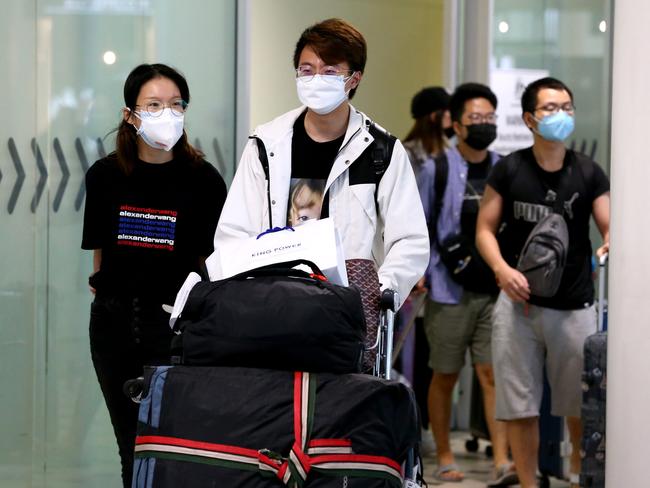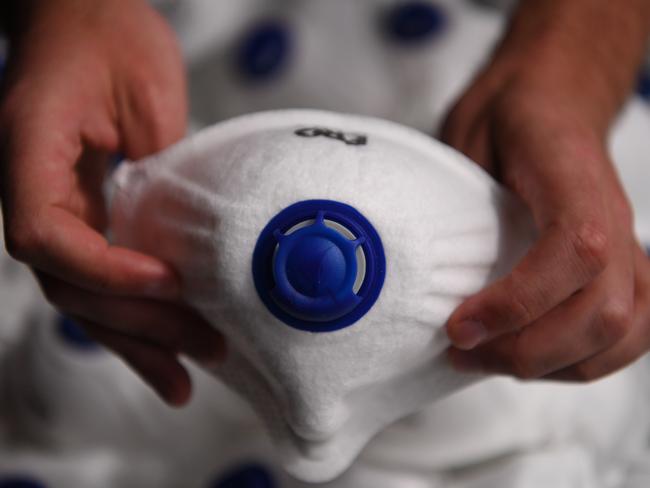Face masks: What you need to know amid coronavirus outbreak
These are the most effective face masks Australians can wear to protect themselves against coronavirus as experts warn not all are created equal.

Health
Don't miss out on the headlines from Health. Followed categories will be added to My News.
Face mask pandemonium has swept across the nation as Australians look to protect themselves from the deadly coronavirus outbreak.
Online interest in face masks has skyrocketed, according to Google Trends, with searches for “bests masks for coronavirus” last week spiking a massive 5,900 per cent in Australia.
They have also been flying out of stores, with the Pharmacy Guild of Australia telling members to keep some face masks in reserve and for staff to assess customers’ needs before selling them.
These are the most effective face masks and how to use them properly.

There are two main types of face mask in Australia — standard surgical masks and P2 masks.
Surgical masks cannot be fitted with an airtight seal and are not regulated on their filtration capacity. However, they can still be effective in protecting against coronavirus.
They must be worn over the face and mouth, with a snug facial fit to ensure there are no gaps.
Disposable surgical masks should not be reused and thrown out when they become damp.

P2 masks – also known as N95 masks – gained popularity when cities were blanketed in smoke during the bushfire crisis.
They are designed to remove 95 per cent of all particles that are at least 0.3 microns in diameter, and can also help protect against viruses if they are fitted properly with an airtight seal.
You should conduct a fit check when wearing a P2 mask.
You can check the seal of the mask by gently inhaling. If it is not drawn towards the face, readjust the mask and repeat the process.
P2 masks should be disposed of when they become damp.
Reusable P2 masks are also available. These should be cleaned and the respirators replaced according to the manufacturer’s instructions to ensure they continue to offer effective protection.

Experts who spoke to News Corp agreed with advice from Australia’s Chief Medical Officer Brendan Murphy that Australians did not need to go about their daily life wearing face masks. However, they conceded it would be difficult to stop consumers rushing out to buy them.
Professor Raina Macintyre, who heads the biosecurity program at the University of New South Wales’ Kirby Institute, said P2 masks offered superior protection.
But she said they should be left for healthcare professionals.
“We really need to reserve all the P2 masks for healthcare workers. They are at most risk and we don’t want a shortage because everyone is unnecessarily buying those,” Prof Macintyre said.
The most appropriate time to wear a face mask was when you were in proximity to someone who is infected, such as around the house, Prof Macintrye said.
If you were going to wear a face mask, it was essential that you also practised good hand hygiene.
She stressed that surgical masks should not be re-used as they could become moist and breed viruses and bacteria.

While reusable cloth masks are available, Prof Macintrye said they appeared to be less effective.
A trial she conducted showed cloth masks had a higher rate of infection than disposable surgical masks.
“This could be because people do not wash them enough, or that they become moist,” she said.
She added the respirators of reusable P2 masks should be changed according to the manufacturer’s instructions.
Associate Professor Dr Deb Friedman, a senior lecturer at Deakin University and infectious disease consultant at Barwon Health, said studies on similar types of virus to COVID-19 showed both surgical and P2 masks were “absolutely effective” in preventing the transmission of these types of infections.
“But we are talking about when you are with a patient that is proven or suspected of having that condition,” Dr Friedman said.
“We’re not talking about members of the general public.”
Dr Friedman said people should only consider wearing a mask, whether surgical or P2, when they have a respiratory illness with symptoms including coughing and sneezing.
“The best reason to wear a mask is to protect other people from what you’re infected with,” she said.
“The other reason is if you are in close contact with a proven or suspected case of an infection.”
She said there was “no use in walking around with a mask on all day”.
Dr Friedman explained face masks help people avoid infection by preventing them from touching their nose and mouth if their hands had become contaminated.
Like Prof Macintyre, she said regularly washing your hands with soap or sanitiser was important.
She said P2 masks were only recommended for infections considered airborne, such as measles and the chickenpox, but it had not yet been established whether the coronavirus fell into this category.
Dr Friedman added P2 masks when worn correctly were uncomfortable to wear for long periods of time. Facial hair could also impact the ability to form a proper seal with the face.
MORE NEWS:
Coronavirus mega guide: What you need to know
How coronavirus will hurt us the most
Does hand sanitiser work against coronavirus?
PM considers ‘Rudd era’ cash handouts for virus
She said surgical masks were “very effective” at preventing transmission provided they were fitted properly over the nose and mouth.
“It stops you from touching your nose and mouth and also keeps you safe when you are within one metre of a suspected or confirmed case,” she said.
Both experts said wearing a mask was not an excuse go out in public if you were ill unless it was absolutely necessary.
Originally published as Face masks: What you need to know amid coronavirus outbreak


